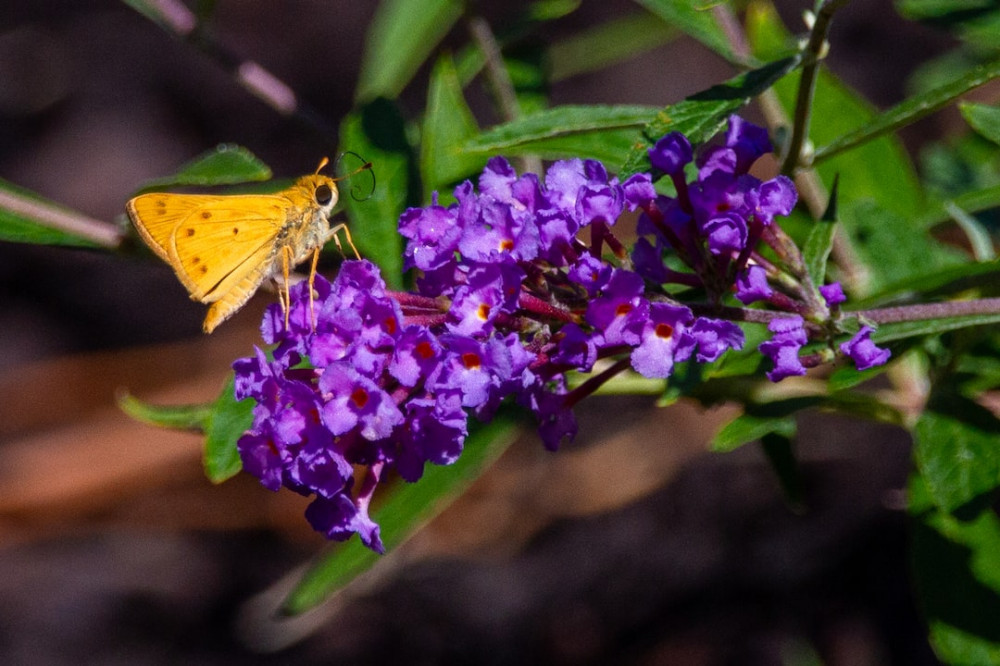Varieties of Butterfly Bushes
.jpg)
Butterfly bushes are great for gardens! They come in a variety of colors, like purple, pink, and white.
Plus, they don’t need much care.
They also bloom for a long time, giving butterflies lots of nectar.
But, they can get big, so pruning is important.
Pro Tip: Plant them near windows or outdoor seating areas, so you can watch the beautiful butterflies!
Benefits of Growing Butterfly Bushes

Butterfly bushes are great for gardens!
They attract beautiful fluttering insects and add color.
Plus, they provide resources for butterflies and other pollinators.
There’s a range of colors and sizes to choose from.
Plant them individually or group them together for a stunning effect. They can grow in various climates and soil conditions.
A friend once told me how she watched her garden come alive with butterflies.
Their graceful movements filled her with joy and a new appreciation for nature’s beauty.
Growing butterfly bushes is a great way to add beauty and help your local environment.
You’ll get to enjoy their vibrant colors and mesmerizing visitors.
Its sure to bring you lots of joy!
Different Varieties of Butterfly Bushes

Butterfly bushes come in many species, each adding a unique charm to a garden.
Consider these six varieties:
- The Black Knight: It has dark purple flowers and adds drama and elegance.
- The Nanho Blue: This one has bright blue blossoms and is great for small gardens or containers.
- The Royal Red: This variety has rich, red flowers. It lures butterflies and hummingbirds.
- The Pink Delight: This one has delicate pink blooms that create a romantic ambiance.
- The White Profusion: It has dense clusters of white blossoms that light up any corner.
- The Golden Glow: This one has stunning yellow flowers, making any garden sunny.

More details: Butterfly bushes are drought-tolerant and easy to maintain.
They also bloom all summer, attracting butterflies, bees and hummingbirds.
A woman once transformed her dull backyard into a butterfly haven.
She selected butterfly bush varieties, creating a landscape with colorful wings fluttering between vibrant blooms.
Her garden soon became known as “The Butterfly Paradise,” drawing visitors from near and far.
These stories inspire us to appreciate nature and its simple joys.
By caring for different varieties of butterfly bushes, we can make an impressive garden and a habitat for these beautiful creatures.
Growing and Care Tips for Butterfly Bushes

Beautiful butterfly bushes attract colorful butterflies to your garden.
Follow these essential care tips for healthy growth and vibrant blooms!
- Choose a sunny spot with well-draining soil.
- Water deeply during dry spells, but avoid over watering.
- Prune in early spring to encourage new growth.
- Apply a balanced fertilizer once in spring and again in midsummer.
These plants have a long blooming period from summer to fall.
They come in many colors such as purple, pink, white, and yellow.
Watch out for pests like aphids or spider mites. Inspect the plants regularly and take appropriate measures if needed.
Fun Fact: Butterfly bush (Buddleja Davidii) is native to China and was introduced to Britain in the late 19th century.
How to Attract Butterflies with Butterfly Bushes
Butterfly Bushes are great for luring butterflies. Planting them in your garden will make a magical environment that attracts these stunning creatures.
Here’s how to use them to attract butterflies:
- Provide nectar-rich flowers. Butterfly bushes have clusters of colorful blooms that are full of nectar, which is the main food for butterflies. Go for varieties like ‘Black Knight‘ or ‘Pink Delight‘ for more nectar.
- Pick the right spot. Butterflies love warmth and sunlight. Place your butterfly bushes where they get six hours of direct sunlight each day. This will help them grow and make them more attractive to butterflies.
- Make a hospitable habitat. Butterflies need more than just nectar. They also need shelter, water, and host plants for their caterpillars. Place other blooming flowers close by, put shallow dishes with water, and have native plants like milkweed to support caterpillar development.
For added butterfly attraction, think about adding a small pond or water feature next to your butterfly bushes.
The gurgling sound of running water will draw in butterflies to your garden while giving them a much-needed drink.
Pro Tip: To make a truly attractive flower buffet, plant a variety of butterfly-friendly flowers near your butterfly bushes. This will entice different species and provide a range of colors and scents for you and the butterflies.
Common Problems and Solutions for Butterfly Bushes
Its key to be prepared for problems with butterfly bushes in your garden.
Here are some solutions to keep them healthy:
- Pests like aphids and spider mites? Inspect your plants and remove any affected parts. Natural insecticides can also help.
- Diseases like powdery mildew and rust? Make sure there’s good air circulation by spacing the plants out properly. Only water at the base of the plant.
- Poor drainage or nutrient deficiencies? Add organic matter or create raised beds. Fertilize with a balanced fertilizer for flowering plants.
- Overcrowded? Prune annually in early spring to maintain an open habit and remove weak or dead branches.
- Winter protection? Apply mulch around the base and wrap with burlap if severe cold is expected.
- Improper pruning? Prune correctly to encourage new growth and maintain shape. Avoid late-season pruning as it can stimulate new growth that won’t harden off before winter.
For a vibrant display of butterflies, act fast to tackle problems with your butterfly bushes.
Enjoy the fluttering wings and the joy they bring! Fertilize with slow-release fertilizer in spring.
Water deeply but infrequently. Start nurturing your butterfly bushes today!
Enjoying the Beauty and Benefits of Butterfly Bushes
Marveling at the Splendor of Butterfly Bushes
Butterfly bushes bring a special beauty to gardens and landscapes with their bright hues and dainty blooms.
They not only look lovely, but they also attract butterflies and other pollinators, making them a vital part of any ecosystem.
Plus, they are adaptable, doing well in all kinds of climates and soil types.
One incredible feature of butterfly bushes is their appeal for butterflies.
The sweet-smelling blossoms and sugary nectar are like an invitation for these graceful creatures.
Seeing a flurry of colorful butterflies in and around the bush creates a magical aura.
Butterfly bushes are great for the environment and gardeners.
They provide homes to helpful insects like ladybugs and lacewings, which keep pests away without harmful chemicals.
Also, they offer food to pollinators.
A gardener once told her story about butterfly bushes.
She loved butterflies but had difficulty luring them to her garden. After planting a butterfly bush near her porch, she saw a big jump in butterfly visits.
She began to savor tranquil mornings with her coffee, surrounded by these delicate creatures.
The beauty of her garden was enhanced and her mornings were made brighter by the butterfly bush.
Frequently Asked Questions
What are the different varieties of butterfly bushes?
There are several popular varieties of butterfly bushes, including Nanho Blue, Black Knight, White Profusion, and Royal Red.
How tall do butterfly bushes typically grow?
Butterfly bushes can reach a height of 6 to 10 feet, depending on the variety and growing conditions.
What is the blooming season for butterfly bushes?
Butterfly bushes typically bloom from mid-summer to fall, attracting a variety of pollinators with their vibrant flowers.
Are butterfly bushes easy to maintain?
Yes, butterfly bushes are generally low-maintenance. They require regular watering, pruning in spring, and occasional fertilization.
Can butterfly bushes grow in containers or pots?
Yes, certain varieties of butterfly bushes can be successfully grown in containers or pots, as long as they are provided with adequate drainage and regular care.
How do I attract butterflies with butterfly bushes?
To attract butterflies, plant butterfly bushes in sunny areas with a variety of nectar-rich flowers nearby. Providing a water source and avoiding the use of pesticides can also help attract butterflies.
Related Topics:





Leave a Reply